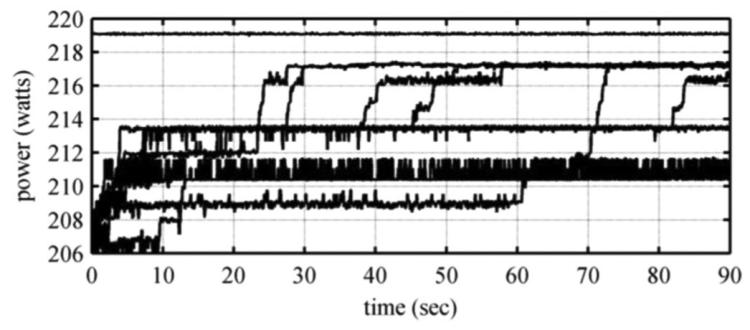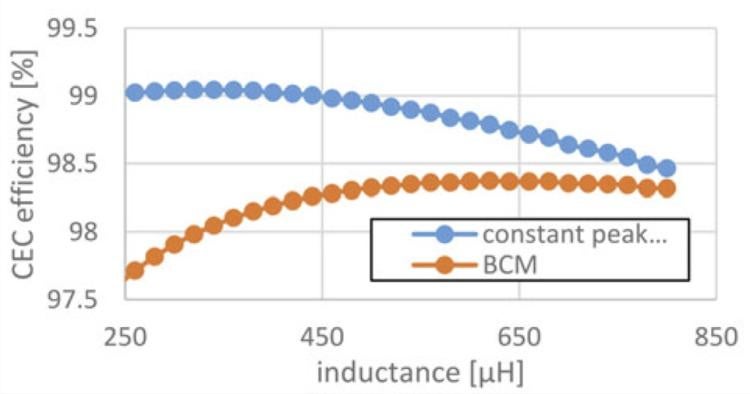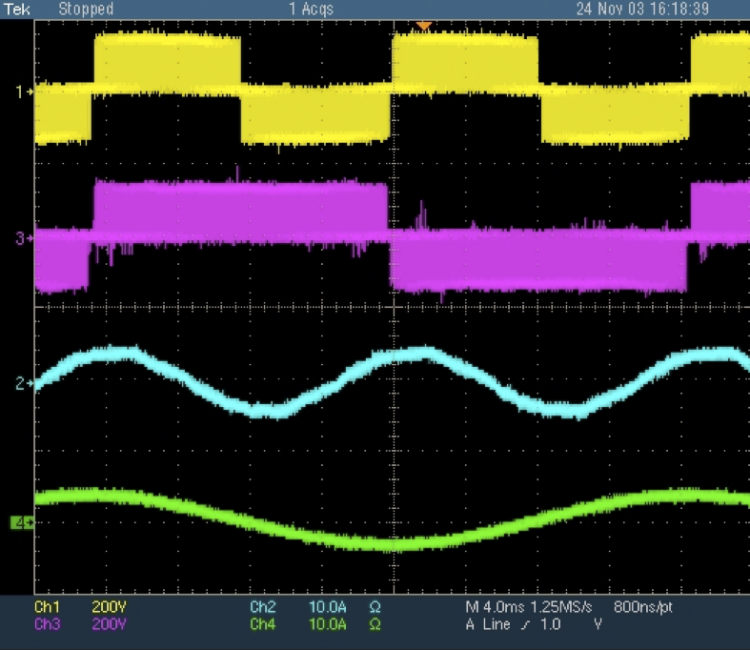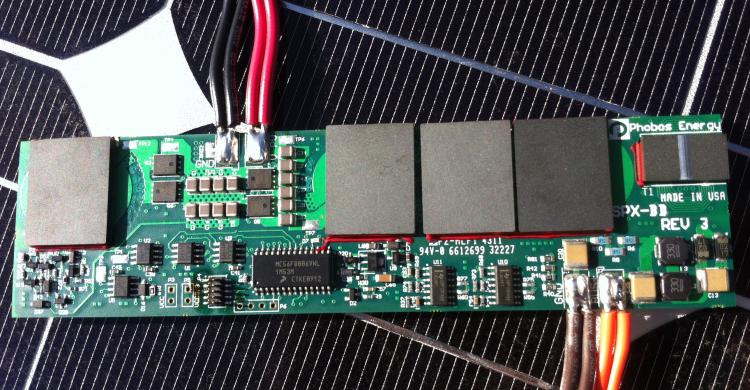Solar and Wind
This research has followed several directions; key published results are summarized below.
Power electronics for building-integrated photovoltaics (BIPV)
Development of new microinverters and dc-dc converters that meet the needs of BIPV. These converters must exhibit extremely high efficiency, operate in the high temperature environment of the rooftop, have lifetimes over 20 years, and have very low profiles to fit inside shingles or similar architectural elements.
L. Linares, R. Erickson, S. MacAlpine, and M. Brandemuehl, “Improved Energy Capture in Series String Photovoltaics via Smart Distributed Power Electronics,” IEEE Applied Power Electronics Conference, Feb. 2009, pp. 904-910.
- R. Erickson and A. Rogers, “A Microinverter for Building-Integrated Photovoltaics,”IEEE Applied Power Electronics Conference, Feb. 2009, pp. 911-917.
This is an early attempt to embed a microinverter into a roof shingle containing 25 W of thin-film PV, such that the shingle output is 60 Hz AC. The tallest component is 3 mm, and ceramic capacitors are employed as the bulk energy storage elements. - R. Erickson, S. Croft, S. Everson, and A. Schultz, "Thin-film photovoltaic power element with integrated low-profile high-efficiency dc-dc converter," U.S. Patent 8,058,752 B2.
Studies of the benefits of distributed maximum power point tracking
Many in the power electronics field have endeavored to increase the energy capture of photovoltaic arrays through the introduction of power electronics that performs maximum power point tracking (MPPT) on a finer level. It has not been clear whether the additional energy captured is sufficient to justify the added expense and insertion loss of these power converters. This sequence of studies quantifies the potential gain of distributed MPPT for different scenarios, in an objective and comprehensive way.
| String | Panel | Sub-Module | Cell |
|---|---|---|---|---|
| Denver Heavy | 1.6% | 16.3% | 18.2% | 29.7% |
| Denver Moderate | 0.8% | 9.3% | 10.4% | 16.7% |
| Denver Light | 0.9% | 3.4% | 4.1% | 7.2% |
| Denver Unshaded | 0.1% | 0.7% | 0.8% | --- |
| Orlando Heavy | 1.4% | 12.5% | 13.9% | 20.8% |
| Orlando Moderate | 0.7% | 6.7% | 7.5% | 11.5% |
| Orlando Light | 0.9% | 3.7% | 4.4% | 6.8% |
| Orlando Unshaded | 0.1% | 0.6% | 0.7% | --- |
S. MacAlpine, R. Erickson, and M. Brandemuehl, “Characterization of Power Optimizer Potential to Increase Energy Capture in Photovoltaic Systems Operating Under Nonuniform Conditions,” IEEE Transactions on Power Electronics, vol. 28, no. 6, pp. 2936-2945, June 2013.
A detailed study of multiple realistic shading scenarios ranging from unshaded to heavy shading, their impact on annual energy generation, and the potential for distributed MPPT to recover some of this lost energy. The results are correlated to the Shade Impact Factor (SIF). Detailed cell I-V curves are employed, with extensive experimental verification. MPPT at the string, panel, sub-module, and cell is compared.- S. MacAlpine, C. Deline, M. Brandemuehl, and R. Erickson, “Measured module performance variation and the opportunity for distributed power electronics: analysis of 27 PV arrays in the southwestern US,” IEEE Photovoltaic Specialists Conference (PVSC), Tampa FL, June 2013.
Dr. MacAlpine gathered experimental data on 27 aging arrays around the US Southwest, to measure and characterize the variations in I-V characteristics over the lifetime of these arrays. The ultimate goal is to provide evidence that supports (or doesn't support) installation of distributed MPPT to mitigate potential mismatch losses arising from aging. - S. MacAlpine, C. Deline, R. Erickson, and M. Brandemuehl, “Module Mismatch Loss and Recoverable Power in Unshaded PV Installations,” 38th IEEE Photovoltaic Specialists Conference (PVSC), June 2012.
This paper investigates the potential for recover energy in PV arrays that are not shaded. The variations in I-V characteristics within an array are modeled, and the potential to recover annual energy via distributed MPPT is computed. - S. MacAlpine, M. Brandemuehl, and R. Erickson, “Beyond the Module Model and Into the Array: Mismatch in Series Strings,” 38th IEEE Photovoltaic Specialists Conference (PVSC), June 2012.
- S. MacAlpine, M. Brandemuehl, and R. Erickson, “Potential for Recoverable Power: Simulated Use of Distributed Power Converters and Various Levels in Partially Shaded Photovoltaic Arrays,” 27th Photovoltaic Solar Energy Conference and Exhibition (PVSEC),Sept. 2011.
- S. MacAlpine, M. Brandemuehl, L. Linares, and R. Erickson, “Analysis of Potential for Mitigation of Building-Integrated PV Array Shading Losses Through Use of Distributed Power Converters,” ASME Fourth International Conference on Energy Sustainability,July 2010.
This paper models the impact of moderate shading in BIPV arrays on their annual energy production. It concludes that distributed MPPT can lead to gains of 3% to 30% in moderately shaded scenarios. - S. MacAlpine, M. Brandemuehl, L. Linares, and R. Erickson, “Effect of Distributed Power Conversion on the Annual Performance of Building-Integrated PV Arrays with Complex Roof Geometries,” ASME Third International Conference on Energy Sustainability, July 2009.
An early paper studying the impact of per-panel module-integrated dc-dc converters on annual energy production of residential rooftop solar when the roof includes multiple facets.
Modeling, design, and control of converters for solar applications
Development of power conversion systems for solar applications required us to solve some significant problems along the way. We published the more notable of these in the papers below.
- D. Jones and R. Erickson, “Probabilistic Analysis of a Generalized Perturb and Observe Algorithm Featuring Robust Operation in the Presence of Power Curve Traps,” IEEE Transactions on Power Electronics, vol. 28, no. 6, pp. 2912-2926, June 2013.

Experimental data for a perturb-and-observe MPPT algorithm. Trajectories are trapped by local maxima, and require many seconds before being dislodged by noise. The maximum power point of the PV panel is approximately 219 W.
The origins of the random walk behavior commonly observed in perturb-and-observe MPPT systems are explained, and a solution is proposed. Converter-generated EMI is aliased by the controller analog-to-digital converter, leading to multiple local maxima in the measured power vs. voltage curve. The perturb-and-observe algorithm is trapped at these small maxima until released by noise. Reducing the EMI levels may reduce the sizes of the aliased maxima, but it also reduces the mechanism that releases the algorithm from these traps. This paper analyzes these systems using discrete-time Markov chain models. A generalized perturb-and-observe algorithm is proposed; with knowledge of the size of the aliased maxima, one can design this algorithm to converge quickly to the correct maximum with minimal random walk behavior. - D. Jones and R. Erickson, “A Nonlinear State Machine for Dead Zone Avoidance and Mitigation in a Synchronous Noninverting Buck-Boost Converter,” IEEE Transactions on Power Electronics, vol. 28, no. 1, pp. 467-480, Jan. 2013.

Block diagram of a digital control system incorporating a DZAM block.
The four-switch noninverting buck-converter exhibits very high efficiency when pass-through modes are employed to minimize switching loss. However, stability problems are observed near the transition between buck and boost modes, caused by the discontinuities in the conversion ratio at the mode boundary. Earlier authors have addressed this problem by introducing simultaneous switching of the buck and boost stages near the mode boundary, which solves the stability problem but increases switching loss. This paper proposes a new DZAM control block that solves the stability problem without increasing switching loss. The DZAM block is a nonlinear state machine that is nearly transparent to the external control loop, and that generates a sequence of buck and boost duty cycle commands that avoid the mode boundary dead zone but that lead to the same effective duty cycle when averaged over several switching periods. By optimal choice of the nonlinearity, increase of the effective switching frequency is avoided. This approach was developed as firmware for a microcontroller having a counter-type PWM. The elegant DZAM algorithm is quite general; we claim that it can be applied to a variety of systems having multiple blocks with passthrough modes. - D. Jones and R. Erickson, “Buck-Boost Converter Efficiency Maximization via a Nonlinear Digital Control Mapping for Adaptive Effective Switching Frequency,” IEEE Journal of Emerging and Selected Topics in Power Electronics,” vol. 1, no. 3, pp. 153-165, Sept. 2013 (invited paper).
This paper shows how to employ the DZAM technique to reduce switching loss in the vicinity of passthrough modes, thereby improving the efficiency of these solar dc-dc converter approaches. This algorithm does not require mode switching, its effective switching frequency approaches zero at the ideal mode boundary, and it is transparent to the external feedback loop. - D. Jones and R. Erickson, “Analysis of Switching Circuits through Incorporation of a Generalized Diode Reverse Recovery Model into State Plane Analysis,” IEEE Transactions on Circuits and Systems I, vol. 60, no. 2, pp. 479-490, Feb. 2013.
Much of our high-efficiency PV converter work has employed dc transformer circuits (DCX) similar to the well-known dual-active bridge but with secondary-side uncontrolled rectifiers, because of their extremely high observed efficiency. Tuning the tank inductor of the DCX according to the stored charge of the secondary diodes is key to maximizing efficiency. This paper employs a state plane analysis including the diode stored charge as a state, to accurately model this important converter. - Y. Levron and R. Erickson, “High Weighted Efficiency in Single-Phase Solar Inverters by a Variable Frequency Peak Current Controller,” IEEE Transactions on Power Electronics, vol. 31, no. 1, pp. 248-257, Jan. 2016.

Comparison of CEC weighted efficiencies of proposed approach and the popular boundary conduction mode approach. The proposed approach achieves substantially higher weighted efficiency with a smaller inductor.
This paper shows how to optimize PV inverter design to maximize its CEC weighted efficiency while minimizing magnetics size. A variable-frequency DCM inverter power stage with weighted efficiency of 99.2% is experimentally demonstrated, and exhibits roughly half the weighted loss of the popular boundary-mode control approach. - Y. Levron, S. Canaday, and R. Erickson, “Bus Voltage Control with Zero Distortion and High Bandwidth for Single-Phase Solar Inverters,” IEEE Transactions on Power Electronics, vol. 31, no. 1, pp. 258-269, Jan. 2016.
This paper addresses the problem of control of the bulk energy storage capacitor voltage when a relatively small film capacitor is employed. Through use of an FIR filter synchronized to the ac line frequency, fast response time can be achieved while avoiding nonlinear stability problems and distortion of the ac line current waveform.
Wind Power Applications of Power Electronics
This research was directed at the power trains of variable-speed wind turbine systems. Of particular interest is to model how the electrical system efficiency varies with wind speed, and to investigate different power conversion approaches for this application.
E. F. Fuchs, A. A. Fardoun, P. W. Carlin, and R. W. Erickson, “Permanent-Magnet Machines for Operation with Large Speed Variations,” Proceedings of Windpower 1992, October 1992.
- O. Al-Naseem and R. Erickson, “Prediction of Switching Loss Variations by Averaged Switch Modeling,” IEEE Applied Power Electronics Conference, February 2000.
This paper describes an equivalent circuit model of switching losses that is experimentally verified, and that predicts observed efficiency vs. power curves. - R. Erickson and O. Al Naseem, "A New Family of Matrix Converters," IEEE Industrial Electronics Society Annual Conference (IECON 01), Nov. 2001.

Experimental waveforms of a modular multilevel matrix converter changing 30 Hz to 60 Hz. PWM voltages and smooth currents are shown.
Multilevel modular conversion is introduced in the matrix converter, allowing scaling of matrix conversion to higher voltage levels. - S. Angkititrakul and R. Erickson, "Control and Implementation of a New Modular Matrix Converter," IEEE Applied Power Electronics Conference, February 2004.
This paper introduces the use of space vector control of the new multilevel modular matrix converter, and presents experimental verification of the proposed control system. - S. Angkititrakul and R. Erickson, “Capacitor Voltage Balancing Control for a Modular Matrix Converter,” IEEE Applied Power Electronics Conference, pp. 1659-1665, March 2006.
Space vector control is extended and refined, to actively control the module capacitor voltages in the modular multilevel matrix converter. - R Erickson, "Directions in Power Conditioning," NREL NWTC Drivetrain Workshop, invited presentation, 10/1/04.
- R. Erickson, "Future Directions in Wind Power Conversion Electronics," Stanford Global Climate and Energy Project, Wind power workshop, invited presentation, April 26, 2004.

A BIPV 250 W boost converter with MPPT is 7 mm thick and fits inside a residential roof shingle.

